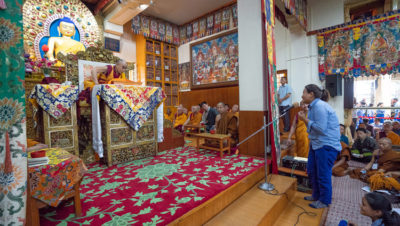
A student asking His Holiness the Dalai Lama a question during a break on the second day of teachings for young Tibetan students at the Main Tibetan Temple in Dharamsala, HP, India on June 7, 2018. Photo by Tenzin Phuntsok
Thekchen Chöling, Dharamsala, HP, India – As soon as His Holiness the Dalai Lama had taken his seat this morning, members of staff from the TCV School at Gopalpur began an energetic presentation of debate. They discussed taking refuge and definitions of the Three Jewels. They were followed by a group of students from the same school who focussed on science—specifically on living organisms. “The foremost scholar of the Nalanda Tradition was Nagarjuna,” were His Holiness’s opening words. “His writings reveal what a great master he was, precise and profound. His students, Aryadeva, Bhavaviveka, and eventually Shantideva elaborated on what he wrote. An early verse in his ‘Fundamental Wisdom of the Middle Way’ demonstrates how he used reasoning to establish the teaching:
Neither from itself nor from another
Nor from both,
Nor without a cause
Does anything whatever, anywhere arise.
“Nagarjuna praised the Buddha, not only for attaining enlightenment, but also for teaching dependent origination. As the final homage at the end of ‘Fundamental Wisdom’ says the Buddha taught the holy Dharma to rid us of all distorted views.
“Our intelligence is deluded by distorted views to uproot which the Buddha first taught the Four Noble Truths beginning with true sufferings and true origins. Detailed explanations of the Four Noble Truths include accounts of the Twelve Links of Dependent Origination. These are sometimes illustrated as the outer ring of the Wheel of Life that can often be found painted on temple verandas. It’s said that the original painting was commissioned by an Indian king.
“We all want happiness, not suffering. And yet, because of ignorance, we are beset by problems. In illustrations of the Twelve Links, the first, ignorance, is depicted as a blind, old woman. The second, volitional activity, is shown as a potter shaping a vase on a wheel.
“Our experience of pain and pleasure comes about as a result of our wholesome and unwholesome actions. The painting includes an inner ring that is half black, alluding to unwholesome actions and half white that indicates wholesome deeds. Many of our actions result from mental afflictions—ignorance, attachment and hatred—illustrated in the centre by a pig, a rooster and a snake respectively.
“Ignorance refers to our misconception of reality, which in his ‘400 Verses’ Aryadeva says permeates our disturbing emotions.
As the tactile sense [pervades] the body
Confusion is present in all [disturbing emotions].
By overcoming confusion you will also
Overcome all disturbing emotions.
“To overcome this ignorance requires making an effort to understand dependent origination.”
His Holiness remarked that everything appears as if it exists objectively and independently. He said that when he looks into the crowd before him he sees schoolchildren and Thai monks, who each look as if they exist from their own side. That is how they appear, but the Buddhist view is that that is not how they actually exist.
His Holiness recalled mentioning yesterday that quantum physicists refer to nothing having objective existence. Today, he referred to an American psychiatrist, Aaron Beck, who has long experience of working with people deeply troubled by anger. Beck told him he had observed that when people are angry they see the object of their anger, usually someone else, in a wholly negative light, but 90% of this feeling is just mental projection. His Holiness considers this a valuable insight.
“All religious traditions regard peace of mind as important. Developing it requires working with our inner world. According to some traditions this involves submitting to God envisaged as infinite love—an approach to peace of mind that depends on faith. Many Indian traditions, however, employ techniques for cultivating a calmly abiding mind and insight (shamatha and vipashyana) to achieve mental peace.
“The Buddhas uproot ignorance and lead beings to liberation by teaching about reality. They don’t wash away wrongdoing with water, nor do they remove suffering with their hands. The historical Buddha observed that each of us is our own master, implying that we can overcome suffering by eliminating ignorance from our own minds. No one else can do it for us.
“The Buddha is the teacher of refuge, but the actual refuge is the Dharma Jewel, the true path and true cessation. Those who have experience of these things are the Sangha Jewel. Ultimately the intention of the Buddha is to lead others to the state he has reached.”
His Holiness resumed reading Chapter Five of the ‘Guide to the Bodhisattva’s Way of Life’ from where he stopped yesterday. He touched on the qualities of a teacher, quoting Je Tsongkhapa, who said that one who will discipline others has to be disciplined themselves.
As he began reading Chapter Six about Patience His Holiness remarked that in order to preserve our peace of mind we need to practise patience and take account of the shortcomings of anger. “No one says I’m happy today,” he quipped, “because I’ve just had a good fight with someone.”
During the intermission His Holiness answered questions from students, after which he completed reading Chapters Six, Seven and Eight of the ‘Guide’. As he brought the session to an end His Holiness mentioned that he is thinking of giving a White Manjushri permission as part of tomorrow’s teachings. https://www.dalailama.com/news/2018/teachings-for-young-tibetan-students-second-day